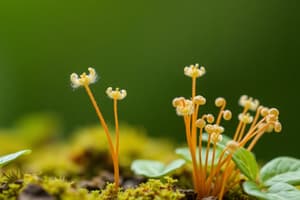Podcast
Questions and Answers
What is a mycorrhiza?
What is a mycorrhiza?
- A parasitic association between a fungus and a plant
- A type of soil bacteria
- A symbiotic association between a fungus and a plant (correct)
- A relationship between two plants
How does the fungus benefit from the mycorrhizal association?
How does the fungus benefit from the mycorrhizal association?
- Receives organic molecules from the plant (correct)
- Produces sugars for the plant
- Provides protection to the plant
- Obtains water and mineral nutrients from the plant
What are the two main types of mycorrhizae mentioned in the text?
What are the two main types of mycorrhizae mentioned in the text?
- Endomycorrhizal fungi and parasitic fungi
- Arbuscular mycorrhizal fungi and ectomycorrhizal fungi (correct)
- Saprophytic fungi and pathogenic fungi
- Rhizomatic fungi and epiphytic fungi
What role do mycorrhizae play in soil biology?
What role do mycorrhizae play in soil biology?
In what circumstances may mycorrhizae have a parasitic association with host plants?
In what circumstances may mycorrhizae have a parasitic association with host plants?
Flashcards are hidden until you start studying
Study Notes
Mycorrhizal Association
- A mycorrhiza is a symbiotic relationship between a fungus and the roots of a plant.
- The fungus benefits from the association by receiving carbohydrates produced by photosynthesis from the plant.
- In return, the plant receives water and minerals from the soil, which the fungus absorbs and transports to the plant.
Types of Mycorrhizae
- There are two main types of mycorrhizae: ectomycorrhizae and endomycorrhizae.
- Ectomycorrhizae form a thick, fungal mantle around the plant root, while endomycorrhizae penetrate the root cells.
Role in Soil Biology
- Mycorrhizae play a crucial role in soil biology by facilitating nutrient cycling, improving soil structure, and enhancing plant water uptake.
- They also increase plant diversity, promote soil aggregation, and support beneficial microbial communities.
Parasitic Association
- In certain circumstances, mycorrhizae can have a parasitic association with host plants, particularly when the plant is under stress or the fungus is over-abundant.
- In these cases, the fungus can exploit the plant's resources, leading to reduced plant growth and productivity.
Studying That Suits You
Use AI to generate personalized quizzes and flashcards to suit your learning preferences.




